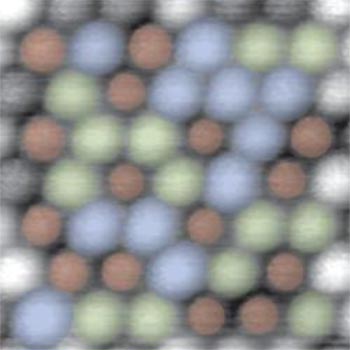|
The chemical identity of individual atoms on a surface can now be determined using an incredibly powerful atomic force microscope.
It means that scientists can now look at a mixed material and pick out individual atoms of different elements on its surface, such as tin or silicon. The advance will allow researchers to understand the structural make-up of complex materials and help them design new ones with unusual properties.
Atomic force microscopes are routinely used to spot individual atoms on surfaces and reveal how they are arranged. But previously, they have not been capable of distinguishing between atoms of different chemical elements.
Now, Yoshiaki Sugimoto at Osaka University in Japan, and colleagues, have found a way to use the atomic force microscope to produce images that reveal the chemical identity of individual atoms on a surface.
Atomic fingerprint
The individual atoms on a surface attract or repel the pyramid-shaped tip of an atomic force microscope as it moves along above them, revealing their presence. The strength of this force depends on how far the atom is from the tip.
The relationship between force and distance is slightly different for atoms of different elements, providing a kind of fingerprint for each type. The researchers took advantage of this to distinguish between atoms of lead, tin, and silicon on a sample surface.
Other research groups had been able to achieve this kind of feat with samples cooled to extremely low temperatures. By carefully compensating for the motion of the sample that occurs at higher temperatures, Sugimoto's group was able to achieve it at room temperature, avoiding the need for cumbersome cooling equipment.
Universal tool
Alexander Shluger at University College London in the UK, who is not a member of Sugimoto's team, says the ability to distinguish atoms of different elements on a surface could be useful for nanotechnology researchers trying to design devices at the molecular level.
"If you want to use this as a tool for manufacturing and a tool for nanotechnology, operating at room temperature is much more convenient, because you don't need all this cryogenic equipment," he told New Scientist.
Scanning tunnelling microscopes are able to make such distinctions, but they only work with conductor and semiconductor materials, a limitation not shared by atomic force microscopes, he says. "This achievement provides a more universal tool for this kind of chemical identification," he told New Scientist.

An atomic force microscope reveals individual atoms of tin, lead, and silicon on a surface, highlighted in the image in blue, green, and red, respectively (Image: Oscar Custance)
http://www.newscientisttech.com/article/dn11272-microscope-discerns-atoms-of-different-elements.html
|
|